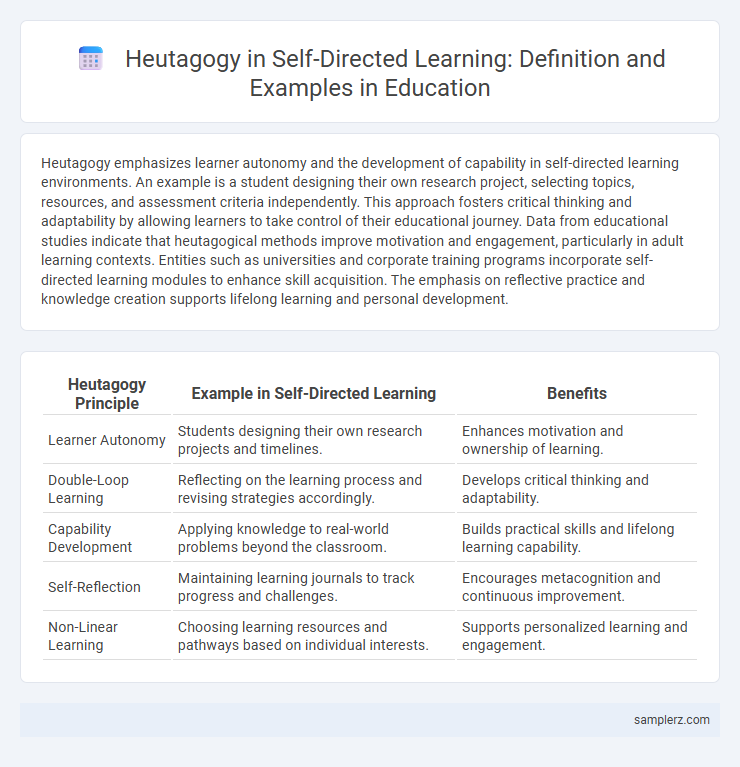Heutagogy emphasizes learner autonomy and the development of capability in self-directed learning environments. An example is a student designing their own research project, selecting topics, resources, and assessment criteria independently. This approach fosters critical thinking and adaptability by allowing learners to take control of their educational journey. Data from educational studies indicate that heutagogical methods improve motivation and engagement, particularly in adult learning contexts. Entities such as universities and corporate training programs incorporate self-directed learning modules to enhance skill acquisition. The emphasis on reflective practice and knowledge creation supports lifelong learning and personal development.
Table of Comparison
| Heutagogy Principle | Example in Self-Directed Learning | Benefits |
|---|---|---|
| Learner Autonomy | Students designing their own research projects and timelines. | Enhances motivation and ownership of learning. |
| Double-Loop Learning | Reflecting on the learning process and revising strategies accordingly. | Develops critical thinking and adaptability. |
| Capability Development | Applying knowledge to real-world problems beyond the classroom. | Builds practical skills and lifelong learning capability. |
| Self-Reflection | Maintaining learning journals to track progress and challenges. | Encourages metacognition and continuous improvement. |
| Non-Linear Learning | Choosing learning resources and pathways based on individual interests. | Supports personalized learning and engagement. |
Understanding Heutagogy in Self-Directed Learning
Heutagogy emphasizes learner autonomy by encouraging individuals to set their own goals, identify resources, and evaluate their progress in self-directed learning environments. This approach fosters metacognitive skills and deep understanding as learners reflect on their experiences and adapt strategies to meet evolving challenges. By prioritizing capability development over rote knowledge, heutagogy transforms learners into proactive agents who shape their educational journeys.
Key Principles of Heutagogical Approaches
Heutagogy in self-directed learning emphasizes learner autonomy, capability development, and double-loop learning, enabling individuals to critically reflect and adapt their knowledge and skills in complex environments. Core principles include nonlinear learning processes, self-reflection, and learner-determined goals, fostering adaptability and lifelong learning competence. This approach prioritizes metacognition and the capacity to learn how to learn, empowering learners to take full responsibility for their educational journey.
Real-World Examples of Heutagogy in Education
Heutagogy in education is exemplified by project-based learning, where students design their own research projects and solve authentic problems, fostering self-directed skill development. Another real-world example is autonomous online courses that allow learners to set goals, select resources, and evaluate their progress independently. These approaches emphasize learner agency, metacognition, and capability building beyond traditional pedagogy and andragogy models.
Designing Self-Directed Learning Activities Using Heutagogy
Designing self-directed learning activities using heutagogy involves empowering learners to set their own goals, select resources, and evaluate their progress independently. Activities often include creating personalized learning contracts, engaging in reflective journaling, and pursuing real-world projects that promote metacognition and adaptability. Incorporating technology-enhanced tools like e-portfolios and online collaborative platforms supports learner autonomy and continuous skill development.
Facilitating Learner Autonomy Through Heutagogy
Heutagogy empowers learners by prioritizing self-determined learning, where individuals actively set their own goals and identify resources, fostering deeper engagement and critical thinking. Facilitating learner autonomy involves educators shifting from traditional instruction to mentorship roles, guiding students in developing metacognitive skills and self-reflection. This approach enhances adaptability and lifelong learning competencies, crucial for navigating complex educational and professional environments.
Technology-Enhanced Heutagogical Practices
Technology-enhanced heutagogical practices in self-directed learning leverage digital tools such as learning management systems, interactive simulations, and AI-driven personalized feedback to empower learners to design and control their educational pathways. These technologies facilitate learner autonomy by providing instant access to diverse resources, real-time assessment, and collaborative platforms that support reflective practice and knowledge co-creation. Integrating mobile apps and virtual reality environments further enriches heutagogical experiences by enabling immersive, context-aware learning tailored to individual goals and preferences.
Case Studies: Heutagogy in Online Learning Environments
Case studies demonstrate that heutagogy enhances self-directed learning by enabling learners to design personalized online curricula based on their interests and goals. Platforms like MOOCs integrate reflective practices and peer collaboration, fostering critical thinking and adaptability. Research shows increased learner motivation and knowledge retention when heutagogical principles guide online education.
Heutagogy and Lifelong Learning Skills Development
Heutagogy emphasizes learner autonomy by encouraging individuals to design their own learning paths, promoting critical reflection and self-evaluation. This approach fosters lifelong learning skills such as adaptability, problem-solving, and metacognition, which are essential for continuous personal and professional growth. Integrating heutagogical principles in education supports the development of self-directed learners who can navigate complex, ever-changing knowledge environments effectively.
Assessment Strategies for Heutagogical Learning
Assessment strategies in heutagogical learning emphasize learner autonomy through self-assessment and reflective journals, enabling students to critically evaluate their progress and identify knowledge gaps. Peer feedback and collaborative projects foster metacognitive skills and deeper understanding by encouraging active engagement and dialogue among learners. Digital portfolios and iterative formative assessments support continuous improvement and personalized learning pathways aligned with individual goals.
Challenges and Solutions in Implementing Heutagogy
Implementing heutagogy in self-directed learning presents challenges such as learner resistance due to unfamiliar autonomy, insufficient digital literacy, and lack of institutional support. Solutions include integrating scaffolded learning technologies, fostering a culture of self-efficacy through targeted workshops, and designing adaptive curricula that align with learner needs and competencies. Emphasizing collaborative platforms and continuous feedback loops enhances engagement and addresses barriers in heutagogical practices.

example of Heutagogy in self-directed learning Infographic
 samplerz.com
samplerz.com